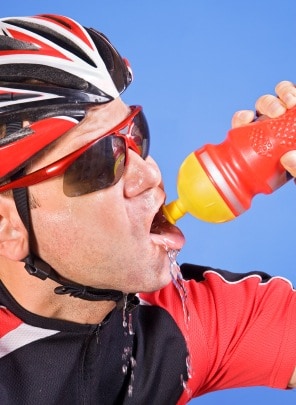Here are some practical tips helping you to become well hydrated after training and cycling races:
The first step towards a better rehydration strategy is to measure your body weight before and after exercise.
By monitoring changes in body mass from pre- to post-exercise, you’ll get important information about your current strategy for fluid intake during exercise.
It is important to emphasize that weight loss after exercise is primarily due to fluid loss.
Unfortunately, fat does not burn so quickly.
Rehydration strategies for cyclists
If your body mass is reduced to less than 1kg after exercise, then there is no hurry to rehydrate. You’ve probably had enough fuel during training to compensate for sweating. So it is also unlikely that this minor fluid loss has any impact on your performance that day.
If your body mass loss is more than 1kg, you can benefit from having a strategy for rehydration. Remember that when you’ve finished a workout, you’ll continue to sweat for a while.
You might sweat more immediately after exercise than when you are on your bike. To recover from the fluid loss, it is recommended to consume app—150% of your weight loss within the following 2 to 4 hours post-exercise to restore fluid balance. The additional fluid volume covers up for constant sweating and urine loss.
If your body mass loss is more than 2kg, then it is likely that dehydration may have hurt your performance. It is also essential to do your best to restore your fluid balance so your dehydration won’t negatively influence your next training session or race.
Be aware that your loss of electrolytes (sodium) is also more significant. Therefore, if you have salt crystals on your skin, you should consider salt-rich foods to restore electrolyte balance.
Please notice that there is no need to add sodium to your food under normal circumstances. A traditional Western menu contains much more sodium than you need.
How to encourage fluid intake
- Make sure that recovery drinks have a refreshing temperature.
- Avoid too hot or too cold drinks may have negative influence on your motivation to rehydrate.
- Adding flavor to your recovery drink may also encourage you to drink more.
How to accelerate rehydration after exercise
- Recovery drinks containing small amounts of sodium and carbohydrates may accelerate gastric emptying. This may also have a positive impact on your refueling process but that is a different story.
- Try being at cool places to minimize ongoing sweating (avoid the 3 S: Sun, Sauna and Spa)
- Avoid caffeine-containg drinks and alcohol.
Five questions to detect dehydration before your next training session
- Do you feel thirsty? (that’s a good indicator)
- Is your tongue dry? (that’s also a pretty obvious sign…)
- Have you visited the toilet as frequently as normal? (small urine volumes is a clear sign of dehydration
- What is the color of your urine? (dark (concentrated) urine is a sign of dehydration)
- What is your body mass compared to body mass the previous day? (again, weight loss from day to day is due to fluid loss)
If you enjoyed this article, please forward the following link to your best friends:
Practical Tips for Rehydration After Exercise


Very practical and easy advice to implement into my daily routine. Never had the thought that fluid balance played such a big role on day-to-day body mass measurements.
@Gustav – Thank you. Try to measure your body mass before/after a spinning class. My PR is a weight loss of 2.7 kg after 50min training.
simple & very helpful article.
Very practical information, thank you!
Thanks for the info, always helpful to read, as stated I try to weigh my self before and after work outs but forget to pay more attention to BMI% and I do worry if I loose 5lbs after a ride. Time for a quality drink and save the beer for later.